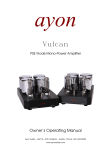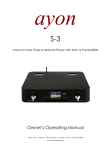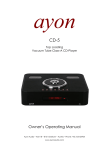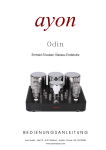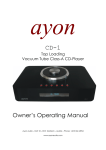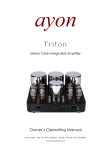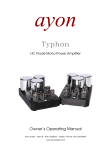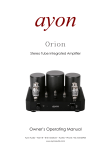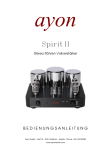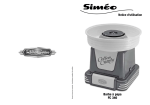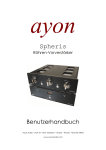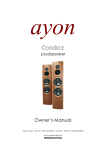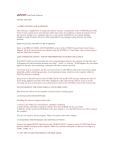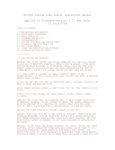Download Ayon Vulcan III Owner`s manual
Transcript
ayon VulcanIII PSE Triode Mono-Power Amplifier Eintakt-Trioden Mono-Endverstärker Owner’s Operating Manual BEDIENUNGSANLEITUNG Ayon Audio – Hart 18 – 8101 Gratkorn – Austria – Phone: +43 3124 24954 www.ayonaudio.com English I N T R O D U C T I ON Thank you for your purchase of the Ayon Vulcan power amplifier. With this amplifier, you have entered into the world of exclusive design which will give you great satisfaction and privilege of enjoying the advanced technology of Ayon Audio products. It is designed to serve as a high standard of truthful real musical performance. The care in engineering and manufacturing of this product anticipates a long time of enjoyment. We also encourage you to enlist the aid of the dealer from whom you purchased this Ayon Vulcan amplifier. Your dealer is an excellent source of information on compatibility, installation, and troubleshooting, and should be capable of helping ensure that your overall music system provides you with maximum performance and satisfaction. SAFETY INFORMATION Please read this owner’s manual to obtain the full benefit of the Vulcan amplifier in your system. This manual provides you with necessary safety information and operation procedures for this unit. To prevent shock or fire hazard do not open the unit or expose to rain or moisture. Refer all service to Ayon Audio Company or an Ayon authorized service facility. There are no user serviceable parts inside the Vulcan. Refer all internal service, updates, or modifications to qualified service personnel. High voltage is present inside operating Vulcan. Do not remove bottom plate or insert any objects through openings in the case. OPERATING VOLTAGE The operating voltage is factory set for the destination country and is not user adjustable. Unauthorized attempts to modify the operating voltage may damage the unit and will void the manufacturer warranty. FUSE The AC power line fuse is located in a snap-out receptacle on the underside of the power inlet (rear panel). The correct value of “slow-blow” fuse is 5A (10A for 120V version). Do not replace the fuse with a higher than indicated. Disconnect the power cord before changing fuse. A blown fuse in your unit can be an indication of a serious problem. If a replacement fuse fails as well, no further attempts should be undertaken. Please contact the factory for professional service. Serial Number: Voltage: Distributor: 2 Ayon Audio – Hart 18 – 8101 Gratkorn – Austria – Phone: +43 3124 24954 www.ayonaudio.com CONTENTS PRECAUTION, INSTALLATION & USER INFORMATION OPEN CARTON – UNPACKING THE VULCAN ACCESSORIES OPERATION YOUR NEW VULCAN 1. 2. 3. 4. 5. 6. 7. 8. Installation of tubes – Installation plan Connecting Turn ON procedure Turn OFF procedure Auto-Fixed-Bias system Tube test program Hum adjustment for power tubes Troubleshooting BREAK-IN PERIOD VACUUM TUBES Tube life expectancy Ayon tube testing process SPECIFICATION WHY TUBE AMPLIFIERS SOME WORDS ABOUT AYON TUBE AMP TECHNOLOGIES AND THEIR BASIS DESIGN USING 4 OR 8 OHM IMPEDANCE TAPS & GENERAL REMARKS ABOUT CABLES/MAINS WARRANTY AND SERVICE 3 Ayon Audio – Hart 18 – 8101 Gratkorn – Austria – Phone: +43 3124 24954 www.ayonaudio.com PRECAUTIONS, INSTALLATION & USER INFORMATION 1. Always be sure your hands are clean and free of any dirt or oil before carrying your Ayon Vulcan. Carry the amplifier with both hands by gripping its side. Handle the Vulcan with respect, it is heavy. 2. Never hold the face plate against your clothing as coarse materials, stitching, belts and the rivets from denim pants can mar the surfaces. Use a soft cloth with non-abrasive cleaning product to clean your amplifier. 3. Gloves or a soft cloth will prevent "fingerprinting" of the tubes during their installation. Do not touch the tubes without the use of a cotton glove or soft cloth. 4. Take care of the precision toggle switch selectors on the rear when moving or transporting the Vulcan. 5. When the unit is on, be careful not to touch the vacuum tubes. Vacuum tubes get HOT. 6. The unit should be put on an adequate ventilated place; The Vulcan gets very warm! Allow clearance of a couple inches in all directions so as to allow air to flow. Do not place the amplifier directly on a carpet or any surface that will block air circulation under the amplifier. 7. Avoid placing the unit indirect sunlight or near sources of damp. Never put any objects directly on top of the unit. 8. The power cord must be earthed . Never touch power plug with wet hands. Please pull out the AC power cord by the plug instead of dragging it. Disconnect from power before removing bottom plate is mandatory. 9. For best performance, place the Vulcan on a solid, horizontal and non-resonant shelf where there is no risk of being knocked or subjected to vibration such as from loudspeakers. 10. The electronics in modern hi-fi equipment is complex and may, therefore, be adversely affected or damaged by lightning. For protection of the audio system during electrical storms, remove the mains plugs. 11. Insert the vacuum tubes in accordance with the designated tube numbers into their relative assigned sockets. Important: Pay close attention to the direction of socket pins never force a vacuum tube into place. Tube should glide right in. If the direction is wrong and you force the tube, damage to the socket pins will occur. 12. Check your speaker connections! Do not operate amplifier without insuring that speakers are connected to the amplifier. Never let run a tube amplifier into a short circuit, the output transformer will soak up a lot of energy before failing, but if the short persists the output transformer could be damaged. 13. Important: To switch on or off always use the power switch of the equipment, the power switch (on/off) is located at the front left corner of the bottom plate. 14. Insure that the Ayon logo, located on the front panel of the Vulcan, illuminates. 15. The Vulcan must be protected from humidity – if the unit is moved from a cold place to a warm room, leave the unit for 3 hours or so to allow sufficient time for the moisture to evaporate. 16. The Vulcan amplifier should not be left running when not in use. If you will not be listening to the amplifier for more than an hour, it is advised that the amplifier be turned off. Unlike solid state amplifiers, tube amplifiers should be shut down when not being used. This will greatly prolong tube life. 17. It is normal for vacuum tube equipment to runs very warm if used for prolonged periods. 18. Do not use a speaker with impedance lower than 3 ohms on either of the outputs. 19. Changing the tubes: Make sure that the amplifier is switched OFF and the tubes are sufficiently cooled down. 20. Warning: Never attempt any measurement or adjustment yourself as voltages inside the tube amplifier can be lethal. Do not work inside a tube amplifier when you are not qualified to do so. 4 Ayon Audio – Hart 18 – 8101 Gratkorn – Austria – Phone: +43 3124 24954 www.ayonaudio.com OPEN CARTON - UNPACKING THE VULCAN Inspect your amplifier for any shipping damage and call your dealer immediately if any is found. Do not plug your amplifier into an AC outlet if you find shipping damage. To avoid damaging the vacuum tubes please don’t turn the cardboard box upside down. Open the box and carefully take out the vacuum tubes and then the amplifier. The amplifier is very heavy! We advise saving all packing materials so that the unit can be easily and safely shipped if the need arises. ● ● ● ● ● ● ● ● ● ● red backlit ayon logo analog bias meter vacuum tube – 6SJ7 vacuum tube – 5U4G vacuum tube – EL84 (6BQ5) vacuum tube – AA62B hum potentiometer for 62B – left & right output transformer power transformers – high voltage & filament/low voltage filtering ACCESSORIES Provided with the Ayon Vulcan amplifier are the following accessories: ( each monoblock ) 2 2 2 1 1 x x x x x AA62B power tubes, EL84 (6BQ5) driver tubes, 6SJ7 signal tube, AC power cord, Owner’s manual for both monoblock’s 5 Ayon Audio – Hart 18 – 8101 Gratkorn – Austria – Phone: +43 3124 24954 www.ayonaudio.com OPERATION 1. Installing the vacuum tubes Please remove the vacuum tubes and the Vulcan from box and place the Vulcan on a firm, level surface. Insert the vacuum tubes in accordance with the designated tube numbers into their relative assigned sockets. It is very important to insert the tubes in the correct location. Pay close attention to the direction of socket pins and their different diameter (AA62B) of pins. The 5U4G and 6SJ7 tubes and their socket have a “nose” too. If the direction is wrong and you force the tube, damage to the socket pins will occur. Never force a vacuum tube into place and also avoid “left-right” tilting, pins can break easily. Tube should glide right in and have to fit tighten (good pin contact). Ensure that all of the tubes are fully seated in their sockets. Note: When inserting and removing tubes, handle them by their bases, not by their glass bulbs. A slight violet glow in the tube is not cause for concern. 6 Ayon Audio – Hart 18 – 8101 Gratkorn – Austria – Phone: +43 3124 24954 www.ayonaudio.com VULCAN III - TUBE INSTALLATION PLAN 1. 2. 3. 4. Install 5U4G tube in position V3 Install 6SJ7 tube in positions V4 and V5 Install 62B tubes in positions V1 and V2 Install 6BQ5-EL84 tubes in positions V6 and V7 All tubes are clearly marked (box) with their correct tube socket positions number! 7 Ayon Audio – Hart 18 – 8101 Gratkorn – Austria – Phone: +43 3124 24954 www.ayonaudio.com 2. Connecting To assure reliable operation always turn the Vulcan OFF while making or changing input or speaker connections. No connections should be made while the amplifier is ON. ► All input and output connectors are clearly marked on the rear panel ◄ Rear panel ● ● ● ● ● ● ● ● ● ● ● input ( RCA or XLR ) speaker output terminal ( common , 4 Ohm or 8 Ohm ) bias – setup push button for auto-fixed-bias system & tube test program (operation by pen) USB “type A” interface for updates/diagnostics via PC – (factory use only, no user options available) bias LED indicator for AA62B ( V1 & V2 ) bias meter selector: position 2 Bias 1 power inlet - with fuse ground switch toggle switch for RCA or BAL (Balanced) mode toggle switch for input sensitivity “Gain” 0dB and –6 dB power phase indicating lamp – 230V Schuko only INPUT CONNECTION: Select RCA or XLR input to connect your preamp and set toggle switch accordingly. Remark: The amplifier has a special single-ended circuit design; therefore we recommend the use of the asymmetric RCA connection! Note for XLR: The XLR input is not a completely symmetric connector but only a "quasi" symmetric connector, because the VULCAN is a single-ended amplifier; i.e. the XLR pins 1 (ground) and 3 (minus) are connected by a small jumper-wire. We provide this XLR connector, because some customers possess more expensive XLR cables and may want to continue to use them; in this case you have to pay attention to the wiring of the output of the preamplifier or to the configuration of the XLR-pins. The configuration of the VULCAN is: pin 1: ground / pin 2: plus + / pin 3: minus –, with pins 1 and 3 shortcircuited. In case your preamplifier has an inverted XLR connector (pin 1: ground / pin 3: plus + / pin 2: minus – ) you must open the internal jumper between pin 1 and pin 3. Furthermore, in connection with the XLR connector a hum loop may occur (primarily in one channel only). First, open the jumper between pin 1 and pin 3. In case the hum loop continues, perform this measure also at the second channel. Grounding always applies to the overall installation; hence the hum is most efficient where the biggest difference in grounding potential appears. In any case connect with an experienced audio dealer for these works. 8 Ayon Audio – Hart 18 – 8101 Gratkorn – Austria – Phone: +43 3124 24954 www.ayonaudio.com INPUT GAIN: Select via toggle switch between 0dB and -6dB. Activating the switch while the VULCAN is running, could cause switching noise. LOUDSPEAKER CONNECTION: There are three sets of gold speaker output terminals at the rear panel: common, 4, 8, ohm. Connect the speaker input terminals to corresponding speaker output terminals at the rear panel according to the impedance of the speaker with high quality audio cord. Pay close attention to proper matching of positive and negative and left and right channels. Note: in general, connecting the Vulcan and the speakers with the 8 Ohm terminal will result in a slightly better sound, even if the nominal impedance of your speakers is 4 Ohms. But this effect differs from speaker to speaker. We encourage you to check it out yourself: listen to you favourite music with both the 4 and the 8 Ohms connection and then decide according to your personal taste. Note: switch the preamplifier to “mute” before changing the wires. POWER INLET: Plug the AC power cord into receptacle. GROUND SWITCH: Make sure that Vulcan monoblock’s are grounded to your wall ground first. If there is a hum loop (hum audible from more than 1 meter from the loudspeakers) flip the grounded/ungrounded switch. If the hum doesn’t disappear then use a two prong plug to “float” the Vulcan. Due to the amplifier’ high power rating, it is important to assure the good quality power line. It is recommended that all units (preamp, CD-Player etc.) are connected to the same phase of the power line. Otherwise, a high level of hum can be present. Another source of hum can be equipment stacked on top of one another. This is not a good plan from the ventilation standpoint generally and it is likely to introduce hum, buzz or noise into the system. Certain gear radiates magnetic fields or high frequency noise around its chassis and other gear may be prone to receiving these fields. It’s also advisable to keep signal and power cables separate where possible. Distance helps greatly. USB Service plug 1. Here various operational parameters, i.e. bias, negative grid bias voltage, circuit protection, delay time for switching on and off, tube test programme, mute and logo function and so on, can be changed with a computer. 2. The USB also serves as a diagnosis port where the service technician can check the operating modes on the computer screen, e.g. bias value, grid voltage, state of the tubes, operating hours, on-off-cycles, and so on; hereby he can recognise problems. 3. Furthermore, software-updates can be performed by the manufacturer or service personnel respectively. PHASE INDICATOR: When the power phase control indicator glows red the Phase polarity is wrong. Reverse the AC plug! This feature was developed only for the safety plug version (EU). For non-EUcountries it can be switched off by means of an internal switch. The phase-light can always glow in the following cases even if the phase is applied correctly: ● in an old electrical installation (old buildings) where the neutral conductor voltage mostly is higher than 0V and this is already sufficient to bring the lamp to glow. ● when an external AC generator is used with a 2 x 115 V balanced output or with a so-called external isolation transformer or power line conditioner. It is recommended that you do not use a power conditioner etc. as it may limit the current available to the amplifier. 9 Ayon Audio – Hart 18 – 8101 Gratkorn – Austria – Phone: +43 3124 24954 www.ayonaudio.com 3. Turn ON procedure When all sources are connected properly, turn down the volume (preamp) to minimum, switch on the power - the Ayon-logo is flashing for a while and then it glows; it will go through a gentle power-on sequence first. Please wait for min. 60 seconds before turning the volume up. After approximately 60 seconds, the unit is operational. Now you can increase the volume. Follow this procedure each time you turn your Vulcan on. Some preamplifiers and sources can generate transients. Source components and power supplies should be always switched on before the power amplifiers. To avoid letting transients reach your loudspeakers turn your system on in the following order: 1) 2) 3) 4) 5) Turn on all sources (CD, tuner, etc.) that you will be using. Turn on the preamplifier. Wait until preamp has stabilized. Power up Vulcan mono amplifiers. Select listening source and play music. During the start-up period the amplifier is controlled by an electronic protection circuit. E.g. in case a tube is defective the amplifier section is switched off. (See section 6 for correction of defects) Note: The Vulcan is using a big dual power supply with large high voltage capacitor storage, during power ON an electrical capacitor charging noise – mild hum may be heard a bit especially when the amp was turn off for a while, as we did not install output relays at the speaker terminals influencing the sound quality. This is not cause for alarm, it is normal. Furthermore the tubes themselves may issue sounds resulting from material tensions (grid – anode plate) or electro-static discharge for a short time when switching on. This “noise” neither damages the loudspeakers nor indicates a malfunction of the amplifier or the tubes. Also a “thump” may be heard from the loudspeakers as power amplifiers are switched on. This is normal, will not cause any loudspeaker damage and does not point to any fault or problem. To switch on or off always use the power switch of the equipment; otherwise the internal microprocessor of the Vulcan cannot recognize or compute various information of the switch on/off process. This may result in significant malfunctions. In General you should always use the power switch of your hi-fi-equipment instead of a so-called external main-switch or the switch of a power strip or a timer etc. These devices may also have a negative effect on the operating life of the equipment, because it is always switched “hard”. 10 Ayon Audio – Hart 18 – 8101 Gratkorn – Austria – Phone: +43 3124 24954 www.ayonaudio.com 4. Turn OFF procedure ● Always turn down the volume to minimum first. When powering down your system, always turn the amplifier off first. The unit can be turned off at any time. Important: If the amplifier was turned OFF even for a short period of time, you have to wait at least 2 minutes before turning it back ON. Do not turn it ON then OFF and then ON again in quick succession. This precaution will minimize the stress (high voltages) on internal components. Note: during these 2 minutes "waiting time" in addition an electronic timer prevents the untimely power-on of the amplifier. At switching off a short „plop/pop“ (discharge of a capacitor or click of a relay) may be heard as we did not install output relays at the speaker terminals influencing the sound quality. These peculiarities are perfectly normal. Always switch amplifiers off and wait 2 minutes before connecting or disconnecting any leads. The amplifier is equipped with a two step release delay circuit. When you power off the amp it takes approximately 40 second time until it’s completely turned off. Meanwhile the protection circuit is activated (disruption), a short but intense switching noise of the relay will be heard from the speakers (the B+ relay under charge disconnects the high voltage of the power tubes). This is no reason for concern but completely normal. Bottom plate Note: The power switch (on/off) is located at the front left corner of the bottom plate! To switch on or off always use the power switch of the equipment! Never remove the bottom plate of the Vulcan before unplugging the unit from the wall! 11 Ayon Audio – Hart 18 – 8101 Gratkorn – Austria – Phone: +43 3124 24954 www.ayonaudio.com 5. Intelligent Auto-Fixed-Bias (AFB) circuitry The bias setting controls the current, thereby the operating point of the tube and therefore is vital for its lifetime and sound. With the bias the power amp can be tuned to cooler/cleaner or hotter/more impure; in the latter case the amp has more punch and can be overdriven more easily. However, too high a bias leads to faster wear of the tubes. For tube amplifiers an "automatic" bias control of the power tubes would be advantageous because differences, aging, or voltage shifting could be compensated more easily or reliably. Furthermore the customer needs not care whether setting of the bias value is correct. Unfortunately, this desirable automatic device has serious disadvantages such as significant deterioration of sound and power. Creating a new automatic "fixed bias" circuit controlling the operating conditions of the power tubes reliably in the specified way WITHOUT negative influence on the sound or output power respectively was a very serious challenge for the Ayon development team. This intelligent Auto-Fixed-Bias system must not be mistaken for a semi-automatic or so called fully automatic bias fixture which can never achieve a result comparable with the new Ayon Auto-Fixed-Bias circuit. The Ayon Auto-Fixed-Bias circuitry delivers the best possible combination of sound properties, measured power and usability because it does not operate during music listening. This system does not result in deterioration of sound, loss of output power, or any other negative concomitants. Additionally the Auto-Fixed-Bias system is equipped with a sophisticated electronic two-way-protection circuit which is always active during the tube test program or the switch-on period respectively. In case of excessive bias current or a defective tube the high voltage is switched off immediately either by a photo coupler controlled "comparator circuit" or by an analog-digital-converter. These protection circuits do not lie in the signal path. ● An added benefit to this approach is that, should a tube fail prematurely, the single tube can be replaced without having to purchase a matched set. Mute LED remark: when the auto-fixed-bias adjustment or the tube test program is active the amplifier always switches into the MUTE mode; this is indicated by the MUTE LED in combination with the blinking ayon-logo. Note: the auto-fixed-bias-system can also be activated manually when the amp is on by pressing the bias-setup-button. Exception: during the 10 minutes after switching on the amp the system is deactivated for safety reasons (the AA62B tubes first must have reached their operating temperature); i.e. in this period you cannot perform a manual activation of the bias-setup. This function is mainly for servicing only and is not really required for the user! The resulting actions are the same as in automatic mode, in principle. Bias meter: The successful operation of the auto-fixed-bias circuit can be also indicated by an analog bias meter located at the top plate. Every power tube can be checked by this bias meter too; the tubes are selected by means of the bias selector switch at the rear panel. Switch the bias selector to the desired tube V1 or V2. When the bias meter doesn’t show the correct value (120-140mV), the particular output tube is maybe defective. Press the “bias-setup” button to see if the bias meter show the correct value again, if not, please changes the tube. (The auto bias system is not able anymore to adjust the bias correctly because of insufficient cathode emission). In this case this tube should be replaced with a known good one and the bias meter should show the correct bias value again. Note: Turn on Bias meter with NO music signal going to the amplifier. Bias meter 12 Ayon Audio – Hart 18 – 8101 Gratkorn – Austria – Phone: +43 3124 24954 www.ayonaudio.com 5.1 Automatic determination of the bias reference value (optimal tube operating temperature) When the amplifier is in operation for more than 45 min (optimal tube operating temperature) an additional bias reference control is performed after switch-off (the LEDs on the back are flashing in order from V1 to V2 during the shut-down process). The measured bias-values are stored and used as a reference value when the amplifier is switched on the next time in order to always provide the best possible working point of the tube (wear out and ageing are taken into account). ● In case the amplifier is switched off after less than 45 min of operation the bias value is not measured; the value stored last is used when the amplifier is switched on the next time. 1. Failure report and bias LED failure indication – bias value too high: In case that during this process the reference control detects that a tube can no longer attain its optimal values or that its functioning at 100% can no longer be assured (bias current too high value), B+ (high voltage) is switched off, the Ayon logo flashes, and the respective tube is indicated by its corresponding LED (V1, V2) on the backside of the amp glowing red. Note: The amp cannot be switched of manually with the power switch. What to do: Set the power switch to OFF-position. Pull off the power cable. Assure yourself that the tubes are sufficiently cooled down (ca. 10 minutes). Replace the tube concerned. Important: even though the AA62B tube is designed to be inserted into the socket in only one orientation (with normal force applied), it’s possible to insert the AA62B the wrong way (with significant force applied). This will cause damage to the tube and/or the amplifier; always keep in mind that the two thick tube pins go into the large socket holes! 5. Connect the power cable again. 6. Switch on the amp; the tube test program is activated automatically. (See also section 6 for correction of defects) 7. After the successful tube test the system automatically switches to operation, the Ayon-logo glows permanently and the amp is ready for music reproduction. 1. 2. 3. 4. 13 Ayon Audio – Hart 18 – 8101 Gratkorn – Austria – Phone: +43 3124 24954 www.ayonaudio.com 6. Activation of the tube test program after a potential tube change The manual activation of the tube test program with the "bias-setup" button becomes necessary after changing the AA62B tubes. The circuit is activated when operating the "bias setup" button while the Ayon logo blinks; this is necessary for the immediate detection of a possibly defective tube (electric short circuit or too high current consumption of the new tube). This way you have maximum security from a short circuit in the tube combined with maximum safety for the amplifier. 1. Switch on the amplifier (power ON), the Ayon-logo blinks. 2. Now press the „bias-setup“ button and keep it for approx. 3 sec (the switching relay creates an audible "click") while the Ayon-logo keeps blinking. The system heats up the tubes for approx. 3 minutes (the Ayon-logo keeps blinking and the amp is muted). After heating-up the automatic bias adjustment starts autonomously and the system checks every tube several times. When all tubes are okay the system automatically switches to operational mode, the Ayon-logo glows permanently and the amp is ready for music reproduction. Note: this procedure takes about 10 minutes and the amp is muted for this period. While the tube test program is active, the amplifier cannot be switched off. Do not interrupt the power supply. Tube test not successful in manual nor automatic activation In case a tube is defective the high voltage of the tube (B+) is switched off immediately. The Ayon-logo blinks, and the tube concerned is indicated by the related red glowing LED (V1, V2) on the rear side of the amp. Note: The amp cannot be switched of manually with the power switch. What to do: 1. 2. 3. 4. 5. 6. 7. Set the power switch to OFF-position. Pull off the power cable. Assure yourself that the tubes are sufficiently cooled down (ca. 10 minutes). Replace the tube concerned. Connect the power cable again. Switch on the amp; the tube test program is activated automatically. After the successful tube test the system automatically switches to operation, the Ayon-logo glows permanently and the amp is ready for music reproduction. Defective tube cannot be identified despite the tube test mode: In case a tube is heavily damaged the system has to switch off again immediately and there is no time to indicate it with the right LED in the tube test mode. Therefore you have to identify this tube yourself by changing tube by tube until you have found the defective one. ● Please contact your dealer when you do not feel comfortable to execute this procedure yourself. Note: after every preceding protective switch-off the tube test program is automatically activated at the next switch-on until the tube test is successful and the amp switches to operational mode. Should the protection circuit continue to activate even after removing the cause, please contact your dealer. 14 Ayon Audio – Hart 18 – 8101 Gratkorn – Austria – Phone: +43 3124 24954 www.ayonaudio.com 6.1. Activation of the auto-fixed-bias system in case of wrongly placed power tubes (socket) In case that you did put the original AA62B tubes in a socket different from the marking on the package (V1, V2) or you do not remember where which tube was to be put, it is mandatory that you manually activate the auto-fixed-bias system, after turn on, wait 2 minutes and then press the bias set up button. This is necessary to find out the new bias reference voltage to enable the “auto fixed bias system” to tune the tube to its best operating parameters. (The “auto fixed bias system” can again control the tube in its optimum bias-window and get the maximum out of it). 7. Hum adjustment for power tubes First, listen to the speaker connected to the power amplifier for excessive hum; correct it if the hum level is too high following the procedure below. You always may have to re-adjust the hum when exchanging power tubes, or when your power tubes appear to be humming. ADJUSTMENT PROCEDURE ■ Switch on (volume to zero position), and wait for normal operation. ■ There is a heater-balance hum potentiometer for each output tube to adjust the outputs for minimal hum as the tubes age. Rotate the screwdriver slowly to listen the changes on the hum level. Try to rotate the pot screw in both directions and listen the effect of the change. Adjust the setting of the hum to its minimum level. The amount of adjustment required should be small. 8. Troubleshooting – in general If you experience any problem with this unit, please take the time to look through this chart and see if you can solve the problem yourself before you call your dealer. No power: Check the connection to the AC power supply. Check and make sure the AC source is not a switched outlet and that, if it is, the switch is turned on. Insert the power cord into the AC inlet of this unit. There is no sound: Press the power switch to turn on the unit, your external pre-amplifier (if any), and disc player etc. Make sure a signal is output from a pre-amplifier or a CD-player etc. Check if the pre-amplifier, speakers and source components are secure connected. Select input setting of the pre-amplifier etc. correctly. Adjust the pre-amplifier volume. The protection circuit is maybe in operation (cut off) when there is no Bias readable. Turn off the unit and solve the cause of problem. Power tube will not bias: If the meter provides a reading but the tube will not bias correctly, the tube is probably bad. 15 Ayon Audio – Hart 18 – 8101 Gratkorn – Austria – Phone: +43 3124 24954 www.ayonaudio.com BREAK-IN PERIOD Your new Ayon Audio electronics Vulcan tube amplifier has an initial break–in period. The unit will not perform to its full sonic potential when first installed in your system. This is partially due to a residual polarization of the dielectric materials used in the PCB, like resistors, capacitors, chokes, transformers and internal wiring. As music is played through the unit, the electrical signal will gradually anneal these materials. Only after the break-in period will the full performance of your Ayon Audio Vulcan is fully realized. The break-in process will occur naturally as music is played through the system. The recommended break-in procedure is as follows: ° Initial warm-up: five to eight hours of quiet music. ° Extended break- in: 30 to 50 hours of mid volume level and dynamic source material. Do not use any CD Break-in Disc or Break-in device. Use natural music only. We have found that certain "break in" CD’s can actually have a detrimental effect on the performance of the system. Note: For best results, do not burn–in your Vulcan continuously for more than 6 - 8 hours. Give the unit a break before you turn it on again. Burn-in the Vulcan without any stress and be sure to use the system, “normally”. During the break-in period, the sonic properties of your unit may undergo several gradual shifts as the various components break–in at different rates. It is therefore suggested that the fine tuning of the system be delayed until after the break–in period is completed. However, during the final phases of the break–in period, the sonic image will open up, the sound stage will bloom to perfection, the bass control and impact will increase and the overall sound will have a more involving sound stage presentation. VACUUM TUBES It is a fact that each brand of tube sounds different in a particular high resolution circuit. This is because no two manufacturers make a tube type in quite the same way, and the central tendencies of the performance parameters will differ slightly with each maker. To emphasize the point, examine the plate structure of any two signal tubes of the same type from different manufacturers. You will probably find that they may not even the same shape and size. Ayon Audio strongly discourages changing tubes (tube rolling) for the purpose of “improving sonic performance”. Tubes of the same part number from different manufacturer’s and lots generally vary considerably in many operating parameters. The Vulcan has been sonically and precisely optimized for the tubes installed at the factory in Austria, by Ayon Audio. All tubes are highly selected and matched tubes by our experts at Ayon Audio. The original signal tubes will provide for many years of excellent audio performance. Tube Life Expectancy Average power tube life will depend on several parameters: product type, how the product is installed, loudspeaker efficiency, room size and acoustic damping, listening habits or average sound pressure levels, A.C. line stability and purity, and other circumstances. When tubes are new they are at slightly greater risk of going bad during their break in period. This is called infant mortality. After the break in time period the tubes will stabilize and last for the several thousand hours of operation unless traumatized by being jarred or dropped. → The vacuum power tubes are high quality AA62B tubes rated for approximately 5000 hours of use. → The vacuum signal tubes are high quality 6QB5 & 6SJ7 tubes rated for approximately 5000 hours of use. For maximum audio quality however we recommend replacing the tubes after 4000hrs of operation. As with all tubes, their quality degrades with age. This is due to cathode emission, a natural process found in all tubes. Note: Some tubes of the same brand and type glow at different brightness levels, some variation in brightness is normal – having to do with the amount and positioning of the internal silvering on the glass. You need not be concerned if one tube glows brighter than another. 16 Ayon Audio – Hart 18 – 8101 Gratkorn – Austria – Phone: +43 3124 24954 www.ayonaudio.com AYON TUBE TESTING PROCESS Every power and signal tube is visually examined and tested by our own special custom made tube testing machine with burn in feature and add on the industry's most advanced computerized electron tube testing system – Amplitrex AT1000 tube tester, for all 5 specs: Plate current, trans-conductance, heater-to-cathode leakage, internal gas and microphonics. Actually tube manufacturer only tests mostly one spec – the plate current in their factory QC process; we test all 5. For tubes with multiple sections such as “dual triode” types, we test all sections of the tube and match the sections as close as possible. SPECIFICATION Amplifier Class of Operation Tube Complement Load Impedance Negative Feedback Bandwidth Output Power Input Impedance Input sensitivity for full power Hum Frequency Response Distortion at 1W Inputs Power consumption Dimensions (WxDxH) cm Shipping dimensions (WxDxH) cm Weight per unit Shipping weight per unit Ayon Vulcan III PSE Triode, Class A 2x AA62B, 2x EL84, 2x 6SJ7,1x 5U4G 4 & 8 Ohms 0dB 8Hz-60kHz 55W 100 KΩ 500mV 0,003 V 10 Hz - 45 kHz/ 0 dB < 0,3% RCA & XLR 230W 36x60x25 cm 78x53x44cm 46kg 56kg Ayon reserves the right to make improvements which may result in specification or feature changes without notice. CE DECLARATION OF CONFORMITYCE DCE DECLARATION OF CONFORMITY We declare under our sole responsibility that this product is in conformity with the following standards or standardized documents: BS EN 60065 in accordance with the regulations 73/23/EEC, 89/336/EEC (from 1 January 1997) CE 94E LA DISPOSAL The crossed out wheeled bin label that appears on the back panel of the product indicates that the product must not be disposed of as normal household waste. To prevent possible harm to the environment please separate the product from other waste to ensure that it can be recycled in an environmentally safe manner. Please contact local government office or retailer for available collection facilities. ayon® is a registered trademark 17 Ayon Audio – Hart 18 – 8101 Gratkorn – Austria – Phone: +43 3124 24954 www.ayonaudio.com WHY TUBE AMPLIFIERS After decades of solid state amplifier innovations, tube amplifiers have staged a powerful comeback in the last ten years, due to their sonic merits. Tubes are the heart and soul of tone! Simpler, purer circuits At Ayon Audio, we feel that tubes are the sonically superior technology for audio, as their generally simpler circuits and smaller number of components provide for a purer signal path and consequently more truthful signal handling. This is because fewer components provide for fewer elements in a circuit to degrade the signal, distort and muddle the sound. Simple circuits also provide for inherently higher reliability, since there are fewer parts which can fail. Tubes are also more tolerant of circuit drifts and deviations in component specifications, and thus can be used in simpler, purer circuits. More benign overload and distortion behaviour A lot of music features great dynamic signal swings, and it has been well established that in tube amplifiers the onset of clip/overload as maximum power is reached is gradual and rising distortion is of predominately low even-order harmonic nature. In comprehensive listening tests, even high levels of even-order harmonic distortion has been found to be significantly less offensive to the ear than even small levels of the harsh, odd order harmonic distortion produced by solid-state circuits when their reach their power limit and enter clipping. In transistor amplifiers, the distortion rise very quickly as the maximum power level is reached, showing almost square wave characteristics, and a high DC component, - which can destroy easily loudspeaker drivers if not stopped to do so. Vacuum tubes and “Tone” The difference in the distortion characteristics between the two technologies can be well illustrated by looking at their effects in guitar amplifier design. Tube guitar amplifier manufacturers have traditionally designed their circuits to drive the output stages into overload distortion, using the resultant distortion to achieve their trademark “tone”. In a tube amplifier, this tone contributes to the amplifier's sound, but in a solid-state amplifier this distortion is audibly intolerable and easily destroys the speakers. When transistors overload (in a discrete circuit or in an OP amp), the dominant distortion product is the third harmonic. The third harmonic "produces a sound many musicians refer to as blanketed”. Instead of making the tone fuller, a strong third actually makes the tone thin and hard. On the other hand, with tubes (particularly triodes) the dominant distortion product is the second harmonic: “Musically the second is an octave above the fundamental and is almost inaudible, yet it adds body to the sound, making it fuller”. Tubes sound better because their distortion products are more musical. Tubes provide a more appropriate load to transducers. Those are the fundamental reasons why tubes simply sound better. Vacuum tubes are the more linear and require less feedback Tubes are voltage amplifiers as opposed to transistors which are current amplification devices. As a consequence, tubes are a more linear amplification technology, requiring less overall negative feedback to make the circuit linear. Negative feedback re-injects a sample of the amplifier’s output signal back into the input, 180 degrees out of phase, in an attempt to reduce amplifier non-linearity and distortion. In practice, negative feedback tends to slow the amplifier down and sucks the emotion and life out of the music. High feedback designs usually sound sterile, boring and lifeless, while low or zero feedback designs provide for a more immediate and natural sound. Depending on technology and type of the used output device, transistor amplifiers generally require the use of over 40dB of local loop or global negative feedback. Superior dynamic capabilities The higher working voltages present in tube amplifiers generally allow for wider voltage swings and better signal headroom before entering into overload territory. Higher working voltages yield higher audible energy storage* with lower value capacitors. 500 volts working voltage in a tube amplifier approximate about 80 volts in a transistor circuit. This is most likely why many listeners feel that tubes sound more powerful. *Audible energy storage is voltage squared divided by 2 multiplied by capacitance. = (V² / 2)* C. 18 Ayon Audio – Hart 18 – 8101 Gratkorn – Austria – Phone: +43 3124 24954 www.ayonaudio.com SOME WORDS ABOUT AYON TUBE AMP TECHNOLOGIES AND THEIR BASIS DESIGN Vacuum Tubes The choice of signal and power tubes have a significant influence on the sound and hence on the inspiration and joy of listening. This is not only the decision between good and bad tubes but finally the interaction of the different types of tubes and their combination that are used in the various Ayon amplifiers. Today only few manufacturers still produce tubes for pure audio amplification; one of them is Ayon Audio with its outstanding single-ended triode power tubes (AA32B-S, AA52B-S and AA62B) based on the WE 300B. Power & Signal tubes and their characteristics used in Ayon amplifiers: AYON AA32B-S, AA52B-S & AA62B: It took us years of research to develop a new groundbreaking generation of super triode power tubes. We design and produce our line of Ayon Audio triode vacuum tubes completely by ourselves in the Czech Republic. That means we are fully independent and extremely flexible. The circuits of our single-ended amplifiers have been specifically designed to take advantage of the groundbreaking sonic properties of the new generation of Ayon "super triodes". All Ayon vacuum tubes possess a vacuum of 10-9 torr, a maximum grid current of 2.2 micro ampere and absolutely constant emission. AYON KT88sx: The Ayon KT88sx “Black Treasure” tube's construction features gold grid wires and an internally coated black glass bottle. This coating is known as Polymer Carbon Compound glass coating and is for its ability to reduce stray electron emission that otherwise is reflected off the glass. This greatly improves the ability of electron emission and electron current stability. The Ayon KT88sx tubes with Ayon Logo are refined and specified for our Ayon amplifiers (perfectly matched with an extremely narrow specification window, superior emission and also re-adapted for the electrical parameters of our amps). 6BQ5/EL84 the power pack of the signal tubes and the ideal driver for difficult power tubes. This tube provides a very neutral and harmonic sound at medium and high frequencies without a predominant bass, with excellent dynamics. This tube was developed only for audio applications. 6189/12AU7 it excels in an extremely balanced and natural reproduction of all frequencies and provides an incredible bass and brilliance at the top-end combined with a very lively sound image. 6H30 holographic three-dimensional structure of sound with comfortable full warmth and fine unobtrusive treble. Very musical large soundstage and finest resolution in mid-range and top end. Linear coherent sound with powerful reproduction of voices. 12AX7 stands for maximum transparency and bass definition. Powerful dense sound with good gain, firm and clear basses, flossy and detailed treble. 6SL7 with a fine and detailed treble and a complex mid-range. Very enjoyable lively sound image with very good spatiality and clear voices. C3m the clear and harmonic top end allows great clean tone and at the same time it offers a mind blowing powerful mid and bottom end and with a very linear and focused sound. Very consistent in detail and separation, with clean heights and exceptional balance throughout. Very dynamic tone with wide frequency range opens up tone with great details tight deep bottom. Very pleasing tonal characteristic giving life to music with nice details and great dynamics. 5U4G classical rectifier tube, makes the sound a bit smoother compared to the use of a solid state rectifier. 19 Ayon Audio – Hart 18 – 8101 Gratkorn – Austria – Phone: +43 3124 24954 www.ayonaudio.com Output Transformer The biggest challenge with designing a big output transformer is that it needs to be as big as possible to be able to handle the bass current, but it gets harder and harder to keep the speed in the top end as the size of the transformer increases. If the coupling is not watched carefully, the capacitance and leakage inductance will roll off the high frequencies. Technically, the design highlights of the new super – wide bandwidth output transformer are a substantial increase in the number of interleaved sections, dramatically improving the coupling between the primary and secondary windings (and even the individual wires) and increasing the efficiency (by lowering the insertion loss) of the transformer. The multiple sections and better winding to winding coupling of the output transformer gives the amplifier the capability to pass full power right out to the frequency extremes, which is the major reason for the wider frequency response and improved resolution, particularly in the top end. The super-wide bandwidth output transformer’s major strength is that it can deliver the current in the bass, while at the same time maintaining the speed in the high frequencies, dramatically improving the square wave response of the amplifier. The effect is a much more natural and relaxed sound with much better clarity, resolution and fluidity. Signal Path We believe that the simplest circuits work best together with the shortest signal path. That is why our SETriode amplifiers to date have used single-ended pure class A circuitry. The shorter the signal path is, the less possibility of sonic degradation from various sources, including the wire itself. Even on the circuit boards, the copper traces are kept to a very minimum length. The completely redesigned circuit board provides a more straightforward and direct approach to the signal paths. Power Supply Single ended amps are more susceptible to power supply aberrations than push-pull amplifiers. The power supplies have been further refined with new components and enhanced AC line noise filtration. Separate power transformers, chokes and filters provide total isolation between the input and output stage which makes this a pure power source and it is a critical attribute for a single-ended amplifier. We also use electrolytic capacitors with much larger storage capacity to make up for the loss in filtering when using resistors in lieu of inductors. Dual Grounding System The modification of the grounding topology leads to increased rejection of noise from the power supply and other areas. The dual grounding topology used in all of our amplifiers is quite unique to the whole hiend tube amplification industry. Such extensive topology provides for quieter backdrop for which the music can unfold in its entirety. It further establishes the quick and controlled bass response and the full bodied expression of the high frequency. The ground leg of the signal has not been neglected and given meticulous attention in its implementation. The importance of proper grounding cannot be over emphasized. Components The type of parts what we are using must have a synergistic relationship to the circuit they are placed in. It is this relationship of which type of part to use where, that ranks our products apart from the mass. High Grade Speaker Binding Post The new Ayon gold plated solid body speaker binding post provide performance levels that are truly in the very High End. The solid body construction ensures that there is no gap or breach in the flow of electrons. The special gold plating provides for superior contact and resistance to oxidation. These speaker binding posts are chosen primarily for their sonic performance, edging out even more expensive counterparts. Mechanical Construction The high grade aluminum chassis impart a richer, more lustrous tonality with a cleaner background and less hash and grain. All brushed anodized anti-vibration-resonance and non-magnetic chassis’s are fully hand assembled to insure the highest level of craftsmanship. 20 Ayon Audio – Hart 18 – 8101 Gratkorn – Austria – Phone: +43 3124 24954 www.ayonaudio.com USING 4 OR 8 OHM IMPEDANCE TAPS Our amplifier has multiple impedance taps: try the 4 ohm taps and 8 ohm taps to see which sound better. They will sound different. It does not matter whether your speaker is specified with 4 or 8 ohms impedance; the impedance curve is never flat over the whole frequency range but normally varies between 3 and 10 ohms, with the exception of short-time peaks. Even a classical 4 ohm speaker may sound significantly better when connected with the 8 ohm tap “against” the technical specification of the speaker – and vice versa. There is no danger of damaging your amplifier or the speakers by using either set of taps. GENERAL REMARKS ABOUT CABLES & MAINS CIRCUITS There is no one best cable to use with our equipment, and there is also no way for us to accurately predict what cables will make your equipment sound best. Research has demonstrated that the cables must be considered an integral part of the music system. Each brand and model and category of cable has its own sonic characteristics and contributes to the overall presentation of the music as much as any active component. Our amplifiers/preamplifiers/CDPlayers/speakers can easily pass the amount of information required to hear these differences between cables. The best cables for your system are your personal taste, the characteristics of your listening room, and the associated equipment. The only person familiar enough with your taste and room characteristics to assist you in selecting cables is someone from your local dealer who has visited your room and sat through listening sessions with you. No one else can adequately evaluate two of the three factors (taste and room). If you wait to select the cables until the other components in the system are set, you can finetune the system with your cable choice. As you evaluate different cables in your system please remember that the dielectric in most quality cables takes several hours to fully form. These cables may not reach their full potential or exhibit their true sonic characteristics until they have been in the system for a week or more. It is important to keep the speaker cables as short as possible. In repeated trials, short runs of inexpensive to moderately priced cable consistently outperformed long runs of the same cable as well as much more expensive cables. If you must place your speakers at a long distance from your electronics, you should consider positioning the amplifier between the speakers and using long interconnect cables with short speaker cables. With comparable lengths and quality long interconnect cables seem to influence the sound of a system less than long speaker cables. An additional advantage is that a given length of interconnect cable will usually cost less than the same length of speaker cable, for bi-wiring in particular An amplifier placed between the speakers can easily be concealed by a plant or placed into a decorative piece of furniture. Interconnect Cables Interconnect plugs and sockets should be kept clean and free from corrosion. The easiest way to clean them is to switch off the equipment, pull the plugs out of their sockets, and push them back in again. Contact cleaners and “enhancers” should not be used as the film they deposit may degrade the sound. Mains Circuits A hi-fi system usually shares a mains circuit with other household equipment some of which can cause distortion of the mains waveform. This distortion can in turn lead to mechanical hum from mains transformers. The Ayon transformers are large in size, making them relatively sensitive to such distortion, and it may be necessary to take account of transformer hum when siting your equipment. Transformer hum is not transmitted through the speakers and has no effect on the performance of the system; however, a separate mains circuit may reduce it. Such a circuit (ideally with a 30 to 50 Amp rating) will also generally improve system performance. Advice on the installation of a separate mains circuit should be sought from a qualified electrician. 21 Ayon Audio – Hart 18 – 8101 Gratkorn – Austria – Phone: +43 3124 24954 www.ayonaudio.com WARRANTY AND SERVICE LIMITED WARRANTY Ayon Audio electronic components are warranted by the manufacturer to be free of defects in materials production for a period starting 2 years (except for wear parts like all types of signal*, rectifier* and power tubes*; AA52B or AA62B power tubes***, CD-mechanism**, laser pick up** and CD-acrylic-lid**), from the date of dispatch (factory). Under this warranty defects are repaired free of charge. The purchaser is responsible for transportation from their location to the original sales agent, national distributor, or international distributor, whoever is closest. This warranty applies to the original purchaser only and it is non-transferable to subsequent purchasers within the original 2 year period. Request for repair under this warranty must be accompanied by an unaltered copy of the original purchase receipt. (3 month*), (6month**) & (1 year***). IN THE EVENT OF A PROBLEM In case of defects, pleases contact at first your dealer. He will ensure continuous operation at the highest level of performance. The defective parts must then be returned to the factory for inspection to determine the status of the warranty claim. This on-site replacement of the parts eliminates the time and expense of shipping the entire unit to the factory for repair. Except as specified below, this warranty covers all defects in material and workmanship in this product. Any implied warranties, including warranties of merchantabilities and fitness for a particular purpose, or damages based upon inconvenience, loss of use of the product, or commercial loss, or any other damages are not covered by this warranty. If at the sole discretion of Ayon Audio it is necessary to ship the product to the manufacturer, please make sure that: • The product is carefully packed and shipped in its original shipping box. • The product is shipped free of charge to us, e.g. you must pay all shipping charges (ex. freight, insurance etc.). CONDITIONS This warranty is subject to the following conditions and limitations. The warranty is void and inapplicable if the product has been used or handled other than in accordance with the instructions in the owner’s manual, abused or misused, electric shorts from lightings or overloaded wall power outlet, the serial identification plate and serial number has been removed from the unit, damaged by accident or neglect or in being transported or the defect is due to the product being repaired or tampered with by anyone other than Ayon Audio, or an authorized party. Further, the following are not covered by this warranty: • Regular inspections, tuning, repairs or replacement of parts which are attributable to normal wear and tear. • Damage occurring during shipment of the product. All transport claims must be presented to the carrier. • Damages or scratches on the surface of the product (ex. metal and chrome parts, color coating etc.). These claims must be presented immediately after the date of original purchase with your dealer. • Damage resulting from incorrect placement, faulty connections, improper operation. Damage resulting from failure to follow instructions supplied with the product. • Damage resulting from accident, misuse, abuse, neglect, electrical surges, lightning or other acts of God. • Damage resulting from repair or attempted repair by anyone other than Ayon Audio or an authorized Ayon dealer. • Consequential, secondary or subsequent damages to other third party appliances. • The device was sold by an unauthorized dealer or sales organization. • The device is operated without ground connection (unearthed). • The device is sent back inappropriately packaged. Some states do not allow limitations on how long an implied warranty lasts and/or do not allow the exclusion or limitation of incidental or consequential damages, so the above limitations may not apply to you. Ayon reserves the right to modify the design of any product without obligation to purchasers of previously manufactured products and to change the price or specifications of any product without notice or obligation to any person. OWNERS MANUAL All rights ® reserved. Reproduction of this manual in any manner without written approval by Ayon is strictly prohibited. Additional copies may be requested from Ayon. Information in this manual is subject to change without notice; Ayon is not liable for any mistakes. This manual has been established to help you. When you think that we could improve something or that we forgot something please let us knows: [email protected] Release: 1st Issue Date: 05th June 2013 ayon® is a registered trademark 22 Ayon Audio – Hart 18 – 8101 Gratkorn – Austria – Phone: +43 3124 24954 www.ayonaudio.com






















